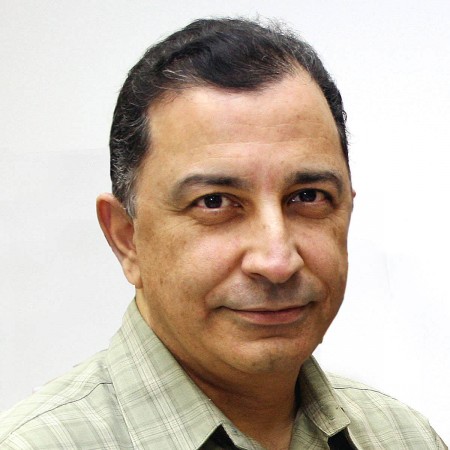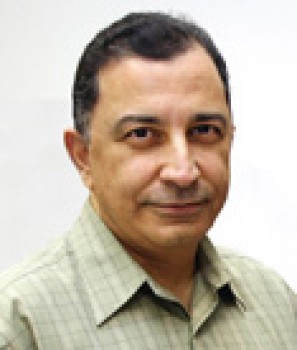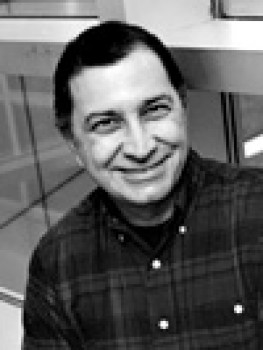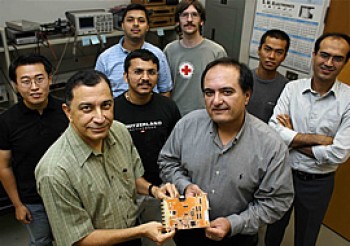
Poras T. Balsara
Vice Dean
Professor - Engineering & Computer Science
Professional Preparation
Ph.D.
Penn State University - 1989
Penn State University - 1989
M.S. - Computer Science & Engineering
Penn State University - 1985
Penn State University - 1985
B.E. (Distinction) - Electrical Engineering
The University of Bombay - 1983
The University of Bombay - 1983
L.E.E. (Distinction) - Electronics & Electrical Engineering
The Victoria Jubilee Technical Institute - 1980
The Victoria Jubilee Technical Institute - 1980
Research Areas
Research Interests
Investigating wide variety of problems in VLSI design, techniques for the design of energy efficient systems, circuits and systems for DSP and communications, digitally intensive/assisted RF, analog, and mixed-signal circuits, efficient control in power electronics, Nano-electromechanical (NEM) relays based digital and mixed-signal circuits, computer arithmetic, reconfigurable circuits, and application-specific architecturesTeaching Interests
Courses related to digital circuits, VLSI Design, introduction to power electronicsPublications
I. Syllaios and P. T. Balsara: “Linear Time-Variant Modeling and Analysis of All-Digital Phase-Locked Loops,” accepted for the IEEE Transactions on Circuits and Systems-I accepted - Publication
S. Modi and P.T. Balsara: Reduced Bandwidth Class H Supply Modulation for Wideband RF Power Amplifiers accepted for the Proceedings of the 13th Annual IEEE Wireless and Microwave Technology Conference (WAMICON2012), Cocoa Beach, FL, April 16-17, 2012 2012 - Publication
S. K. Manohar, R. Venkatasubramanian and P.T. Balsara: “Hybrid NEMS-CMOS DC-DC Converter for Improved Area and Power Efficiency” Proceedings of the 25th International Conference on VLSI Design (VLSI ‘12), Hyderabad, India, January 8-11, 2012, pp. 221-226. Best Paper Award Nominee 2012 - Publication
S. K. Manohar, V. K. Somasundar, R. Venkatasubramanian and P.T. Balsara: “Bidirectional Single-Supply Level Shifter with Wide Voltage Range for Efficient Power Management” Proceedings of the 25th International Conference on VLSI Design (VLSI ‘12), Hyderabad, India, January 8-11, 2012, pp. 125-130. Best Paper Award Nominee 2012 - Publication
A. Awasthi, N. Al-Dhahir, Oren Eliezer, and P.T. Balsara: Alien Crosstalk Mitigation in Vectored DSL Systems for Backhaul Applications accepted for the Proceedings of the IEEE International Conference on Communications (ICC 2012), Ottawa, Canada, June 10-15, 2012 2012 - Publication
R. Venkatasubramanian, S. K. Manohar, V. Paduvalli, and P. T. Balsara: “NEM Relay Based Memory Architectures for Low Power Design,” Proceedings of the 12th IEEE International Conference on Nanotechnology (IEEE NANO 2012), August 20-23, 2012. 2012 - Publication
R. Venkatasubramanian, S. K. Manohar and P. T. Balsara: “Nano-electromechanical Relays in Integrated Power Management" An Energy Efficient Alternative,” 2012 US-Korea Joint Symposium of Nanotechnology, Grapevine, Texas, May 1-4, 2012. 2012 - Publication
J. Mehta, R. B. Staszewski, G. Feygin, O. Eliezer, M. Frechette, and P.T. Balsara: “Mismatch Considerations in an RF-DAC Design for a Digital Polar EDGE Transmitter,” Proceedings of IEEE International Symposium on Radio-Frequency Integration Technology (RFIT2011), Beijing, China. Nov. 30 -- Dec. 2, 2011, pp. 169-172. 2011 - Publication
Appointments
Associate Dept. Head
University of Texas at Dallas [2012–Present]
University of Texas at Dallas [2012–Present]
Visiting Researcher
Texas Instruments [2003–2003]
Texas Instruments [2003–2003]
Professor
University of Texas at Dallas [2000–Present]
University of Texas at Dallas [2000–Present]
Associate Professor
University of Texas at Dallas [1995–2000]
University of Texas at Dallas [1995–2000]
Assistant Professor
University of Texas at Dallas [1989–1995]
University of Texas at Dallas [1989–1995]
Additional Information
HONORS & AWARDS:
- Best Paper Award Nominee at the 25th IEEE International Conference on VLSI Design (VLSI ‘12), Hyderabad, India, January 8-11, 2012
- Best Teacher Award, Erik Jonsson School of Engineering and Computer Science, April 2006.
- 2nd Best Entry Awardat the Chip Design Contest, 19th IEEE International Conference on VLSI Design (VLSI ‘06), Hyderabad, India, January 3-7, 2006
- Best Paper Award, 5th International Workshop on System-on-Chip (IWSOC), Banf, Canada, July 20-24, 2005.
- Best Paper Award,IEEE International Conference on Computer Design, October 2004.
- The UT Dallas Erik Jonsson School of Engineering and Computer Science Award for Exemplary Contributions to Ph.D. Education and Research, April 2005.
- The UT Dallas Erik Jonsson School of Engineering and Computer Science Outstanding Service Award, August 2003.
- National Science Foundation Research Initiation Award, 1990
- Gold Medal, Victoria Jubilee Technical Institute, Bombay, India, 1980
Patents
-
L. R. Hunt, P. T. Balsara & D. Bhatia: “System, Apparatus and Methods for Controlling Multiple Output Converters,” Patent Filed, November 22, 2011
-
S. Kundapur & P. T. Balsara: “High Performance Bidirectional Single-Supply Level Shifter,” Provisional Patent filed, August 2010.
-
K. Kiasaleh & P. T. Balsara: “System, Method and Apparatus for Providing Communications that Conform to a Cellular Communication Standard and a Non-Cellular Communication Standard,” United States Patent Number 8,260,279, September 4, 2012
- P. T. Balsara & K. Koshy: "Design of Basic Digital Logic Gates using Resonant Tunneling Diodes (RTDs) and Standard MOSFETs" and "Design of a Binary Full Adder Circuit using Resonant Tunneling Diodes (RTDs) and Standard MOSFETs," United States Patent Number 6,130,559, October 10, 2000.
Graduate Research
News Articles
UT Dallas Spinoff Receives $250,000 from State Tech Fund
 Researchers in UT Dallas’s Erik Jonsson School of Engineering and Computer Science invented a control method and specialized algorithms that allow power converters to be more useful in power environments requiring high levels of stability and precision, or that must manage varying levels of voltage. The University licensed the technology to Cirasys for further development and commercialization. Dr. Louis Hunt, professor emeritus of engineering, is chief scientist at Cirasys and a co-inventor of the technology with adjunct professor Dr. Robert J. Taylor (PhD’04). Dr. Dinesh Bhatia and Dr. Poras Balsara, both professors of electrical engineering, are involved in the research and development.
Researchers in UT Dallas’s Erik Jonsson School of Engineering and Computer Science invented a control method and specialized algorithms that allow power converters to be more useful in power environments requiring high levels of stability and precision, or that must manage varying levels of voltage. The University licensed the technology to Cirasys for further development and commercialization. Dr. Louis Hunt, professor emeritus of engineering, is chief scientist at Cirasys and a co-inventor of the technology with adjunct professor Dr. Robert J. Taylor (PhD’04). Dr. Dinesh Bhatia and Dr. Poras Balsara, both professors of electrical engineering, are involved in the research and development.
Research Shines Light on Circuit Design Program
 The integrated circuit design program at UT Dallas is turning heads: Three of the program’s papers were recently ranked among the top 50 downloads from the Institute of Electrical and Electronics Engineers.
The integrated circuit design program at UT Dallas is turning heads: Three of the program’s papers were recently ranked among the top 50 downloads from the Institute of Electrical and Electronics Engineers.The University’s integrated circuit design program has expanded in recent years to more than a dozen professors and several dozen graduate students in the Department of Electrical Engineering.
“This says the work we’re doing is highly relevant and top-quality,” said Dr. Kenneth K. O, a professor of electrical engineering and director of the Texas Analog Center of Excellence (TxACE) at UT Dallas. “And it’s rare that one institution has this many papers in one research area at once.”
Government Boosts Funding for Wireless Project
 Electrical engineering faculty Poras Balsara (left) and Kamran Kiasaleh hold the circuit board containing the software-defined radio technology that their team is developing. Other members of the team are (second row, from left) graduate students Xiaojiang Tian, Jay Shah and Ali Montazeri, and (third row, from left) grad student Gaurav Sureka, undergraduate Allen Webb and grad student Liu Zhengjie. Team members not pictured are grad student Essam Atalla, former grad student Beilei Zhang and associate professor of electrical engineering Dinesh Bhatia.
Electrical engineering faculty Poras Balsara (left) and Kamran Kiasaleh hold the circuit board containing the software-defined radio technology that their team is developing. Other members of the team are (second row, from left) graduate students Xiaojiang Tian, Jay Shah and Ali Montazeri, and (third row, from left) grad student Gaurav Sureka, undergraduate Allen Webb and grad student Liu Zhengjie. Team members not pictured are grad student Essam Atalla, former grad student Beilei Zhang and associate professor of electrical engineering Dinesh Bhatia.
Government Boosts Funding for Wireless Technology Project at UT Dallas
The federal government has extended a contract with researchers at The University of Texas at Dallas to develop wireless communications technology that can easily skip from one standard to another, enabling ubiquitous connectivity.The technology is being developed for emergency workers, but it’s expected to find eventual consumer applications as well.
Known as software-defined radio, the secret to the technology lies in software modules that run on an all-purpose processor. That differs from the usual approach, in which cell phones are hardwired to work with just one type of signal.